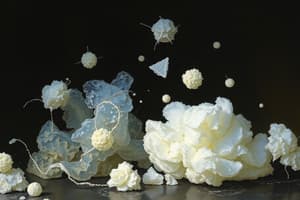Podcast
Questions and Answers
Explain the three main states of matter.
Explain the three main states of matter.
The three main states of matter are solid, liquid, and gas.
What are some examples of each state of matter?
What are some examples of each state of matter?
Examples of solid are ice and wood, liquid examples include water and milk, and examples of gas are oxygen and helium.
What are the two types of mixtures?
What are the two types of mixtures?
The two types of mixtures are homogeneous mixtures and heterogeneous mixtures.
What are the three main states of matter?
What are the three main states of matter?
What are the two types of mixtures?
What are the two types of mixtures?
Can you provide an example of each state of matter?
Can you provide an example of each state of matter?
Explain the three main states of matter and provide examples of each.
Explain the three main states of matter and provide examples of each.
What are the two types of changes that can occur to matter?
What are the two types of changes that can occur to matter?
How do the particles in each state of matter differ in terms of arrangement and movement?
How do the particles in each state of matter differ in terms of arrangement and movement?
Flashcards are hidden until you start studying




